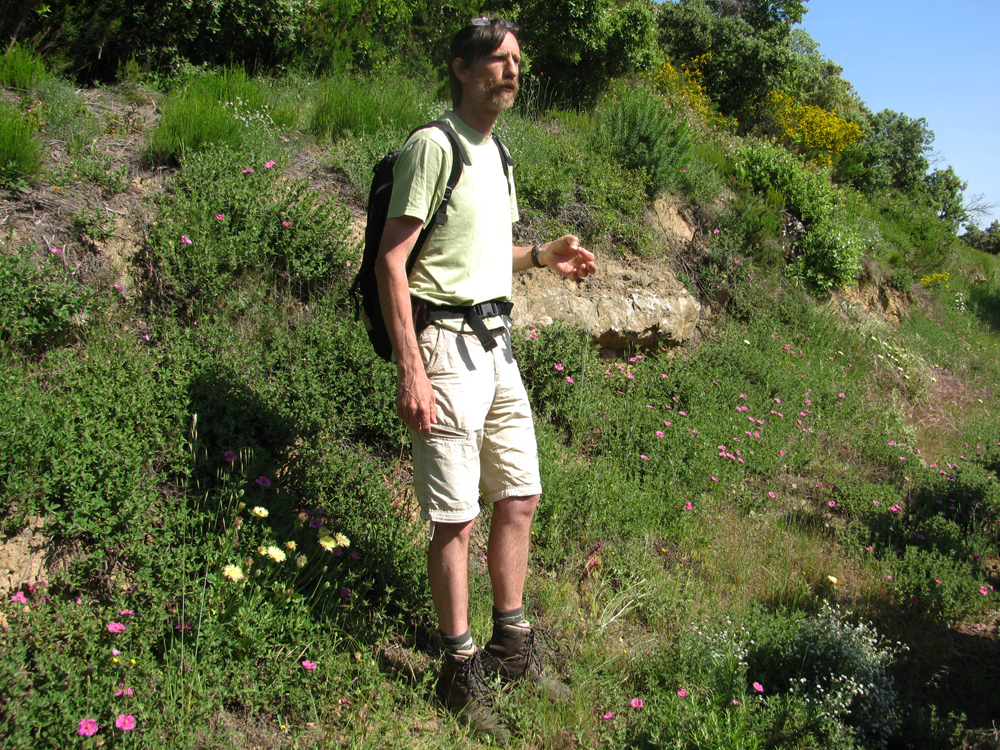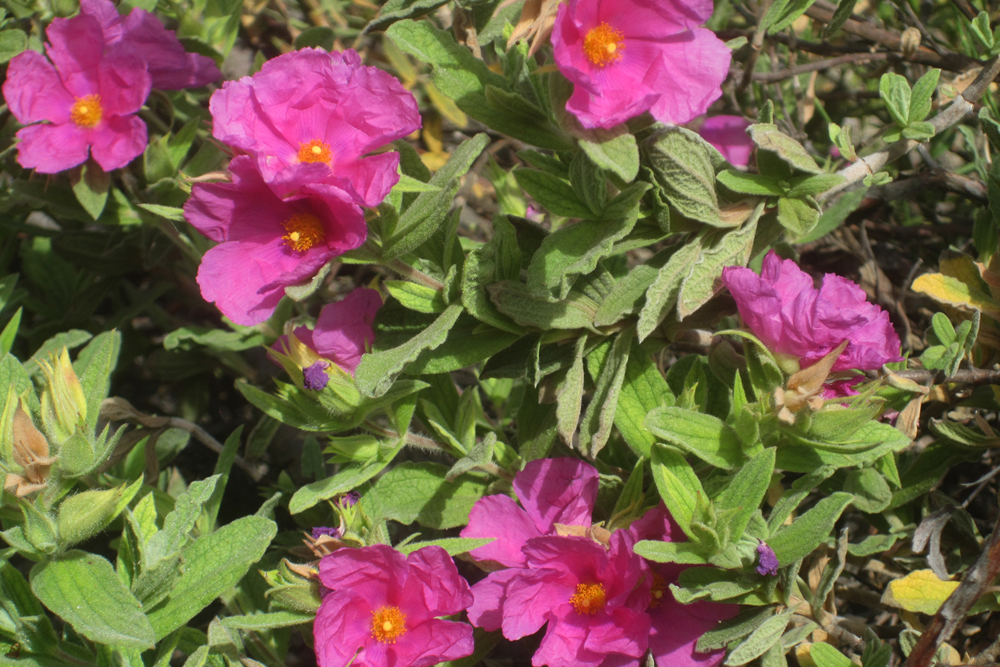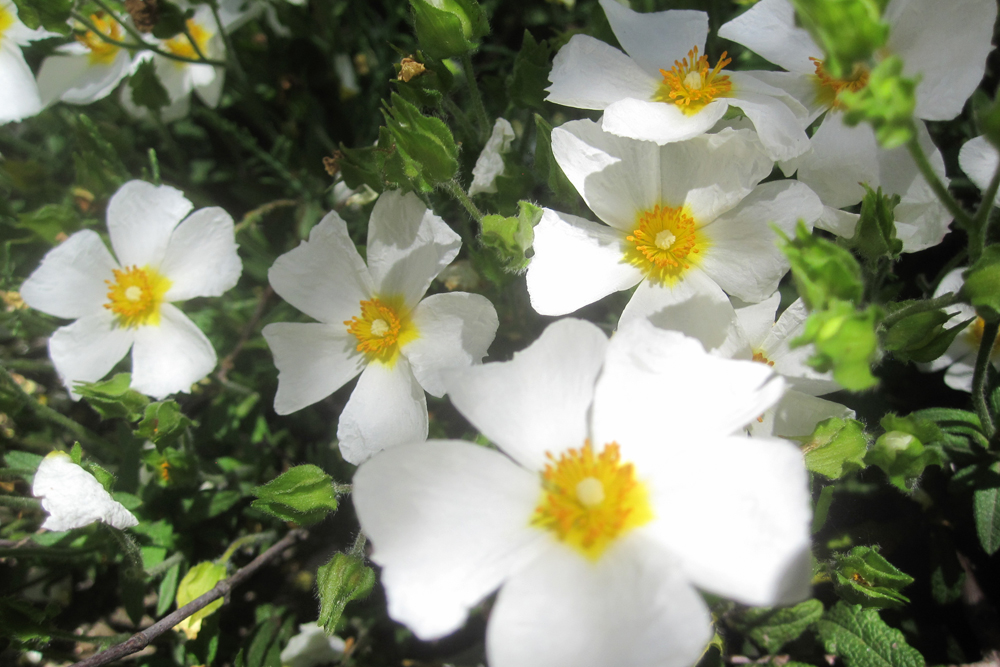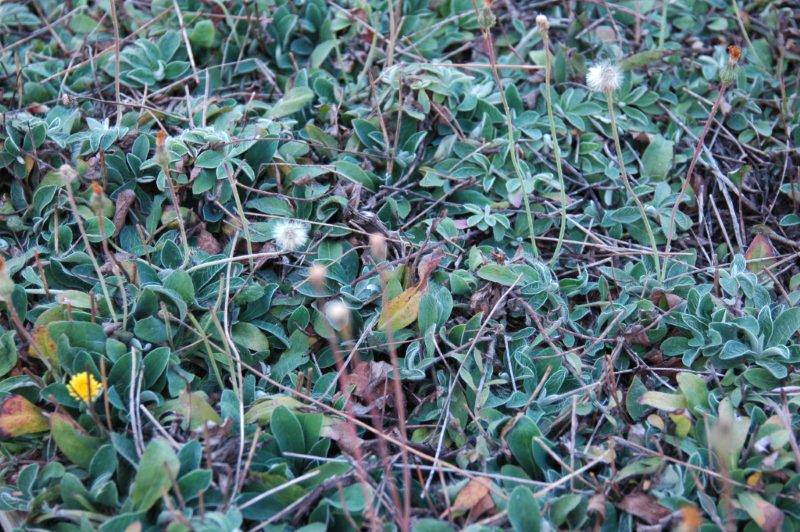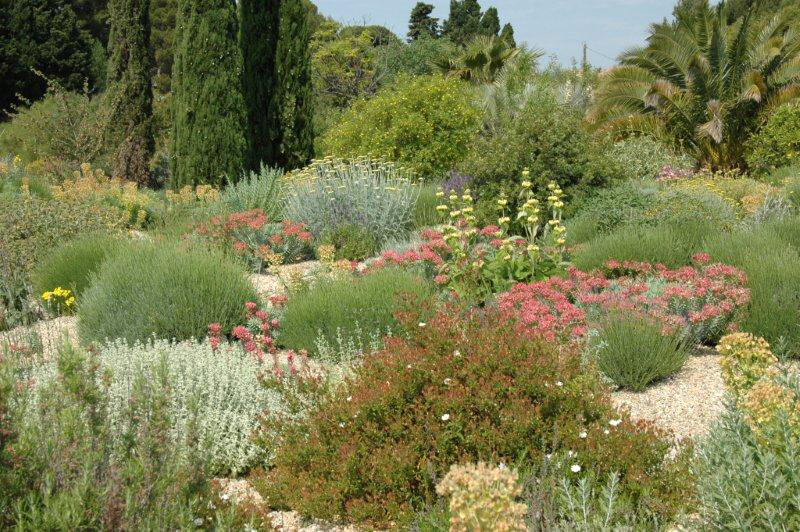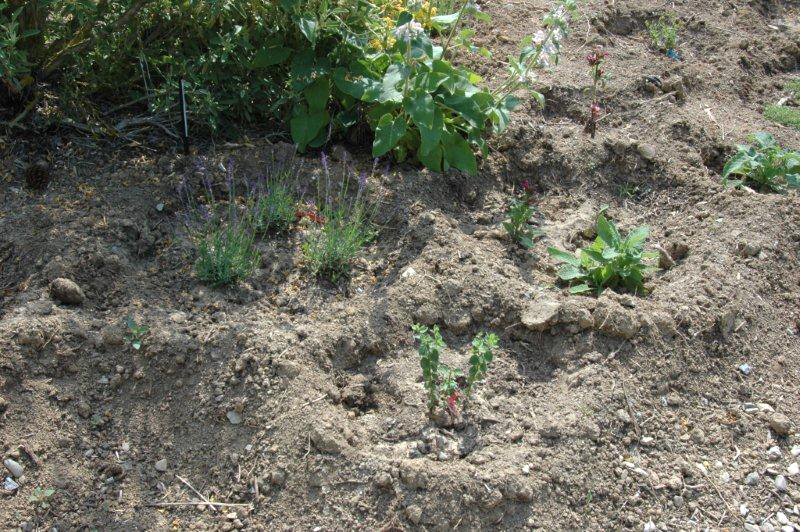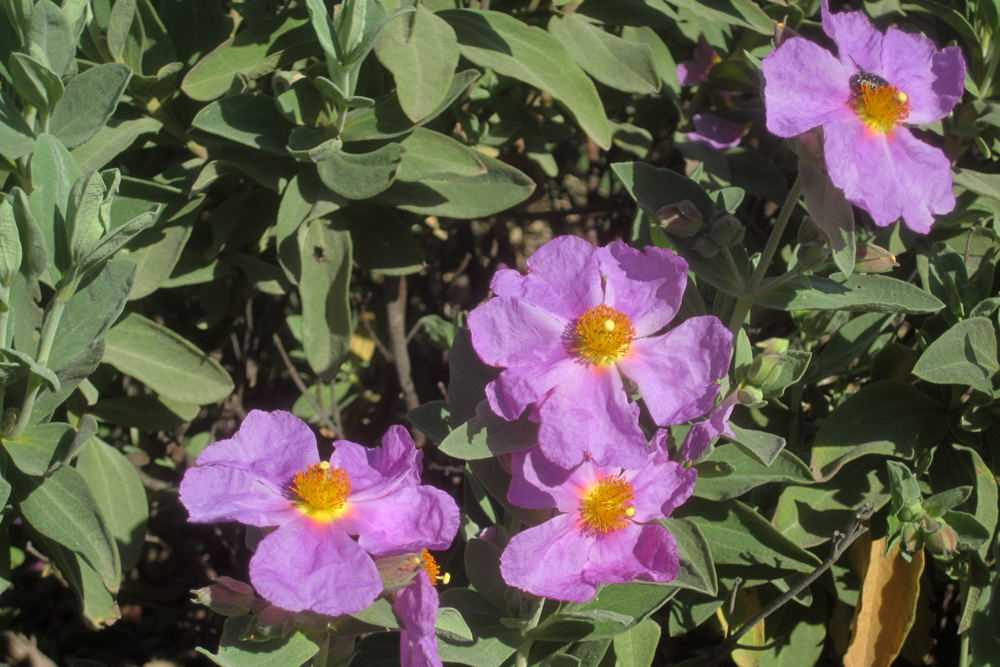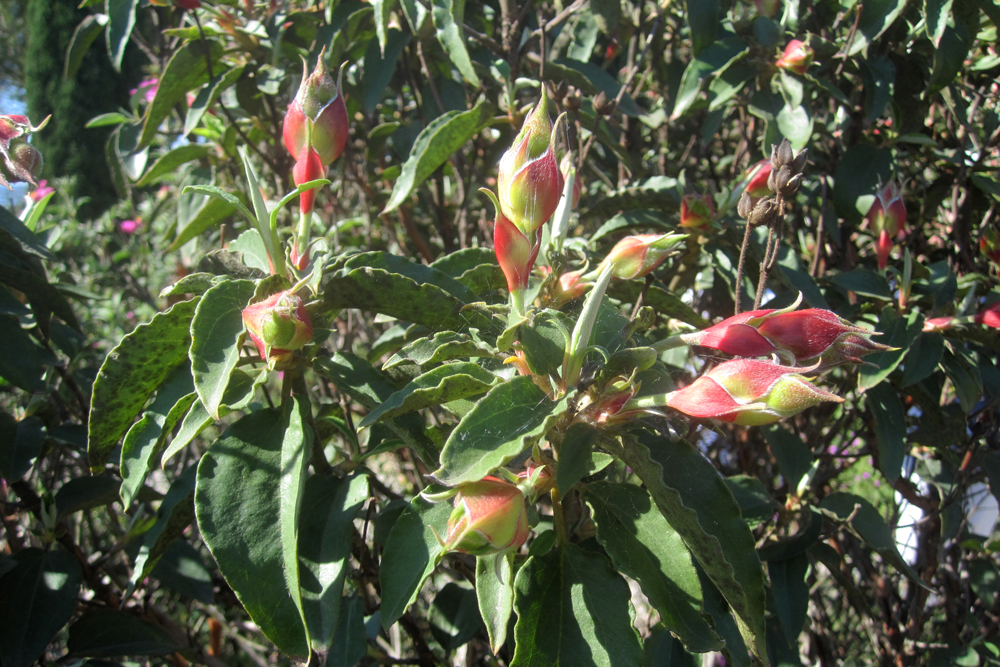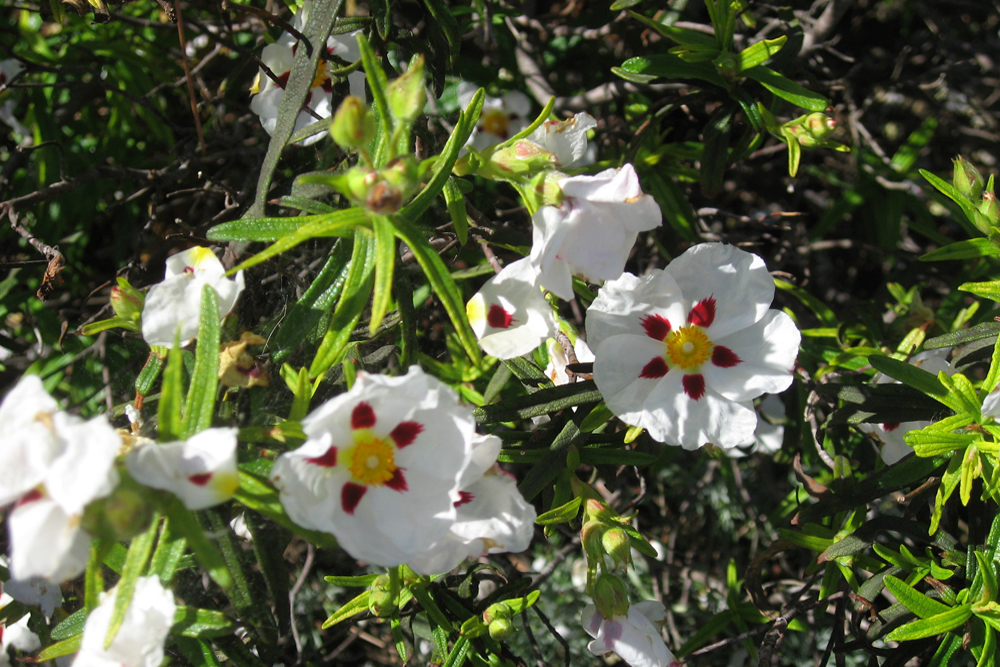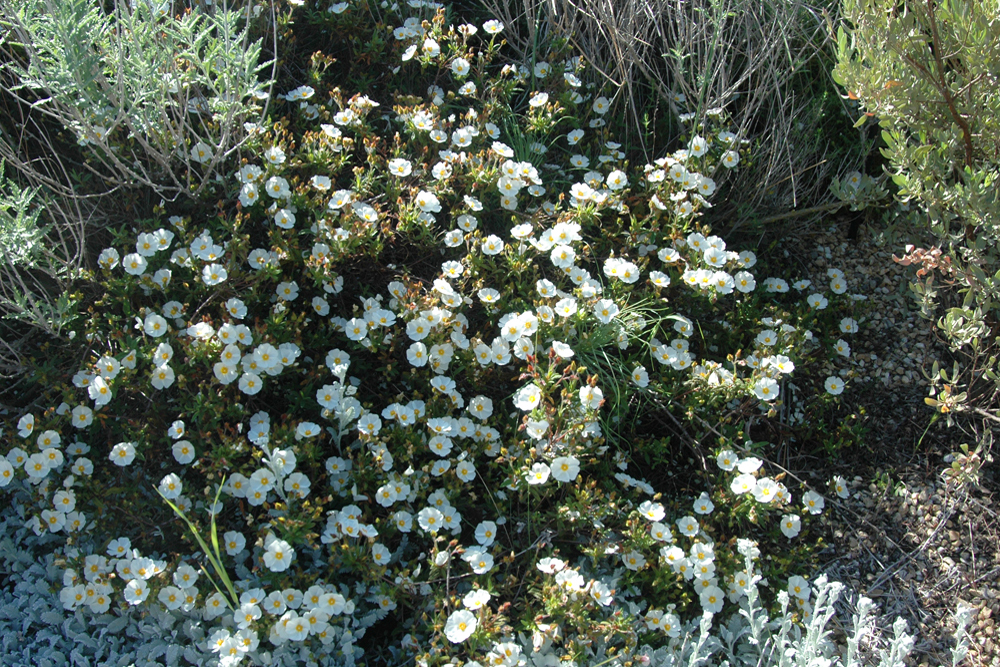Plants / Plantes
Cistuses in natural and garden settings
Click on an image to enlarge it / Cliquez sur une image pour l’agrandir
On a sunny day in May, Olivier Filippi took a large group of us on a ramble through the garrigue, stopping frequently to point out certain plants and in particular the extraordinary nature, diversity and infrastructure of the garrigue itself.
Cistus growing wild in the garrigue have been studied for centuries. There are 9 taxa of cistus to be found in this area, including five species and four natural hybrids. Many of these hybrids have become classic garden plants, for example, Cistus x pulverulentus, Cistus x florentinus and Cistus x hybridus var. corbariensis. By observing them in their natural habitat we can understand how to give them the most suitable growing conditions in the garden.
Of vital importance is the air trapped within the growing medium – even within rocks which contain cracks full of air allowing plants to flourish. Cistuses were everywhere, and these incredibly beautiful and intriguing plants have developed over aeons to exist under harsh conditions. Some species are acid-loving, others lime-loving; hybrids have developed which share the genes of both parents, able to thrive in both acid and alkaline conditions. Of course, there are no fertilisers or herbicides in the garrigue, which would be fatal to cistuses as they depend on beneficial mycorrhiza. The message continuously drummed into us was that if we want a successful Mediterranean garden, then we must duplicate these natural conditions of the garrigue – no watering, no chemicals.
The garrigue has developed with help from fire and sheep. Pine trees are an invitation to fire, we were told, Olivier compared pine cones to hand grenades just waiting to explode. Without fire or grazing, the pines would overcrowd the plants below, greatly reducing the natural diversity.
Typical garrigue plants have sticky leaves and are covered in essential oils which protect them both from heat and from insect predators. When the leaves fall, after three years they form a natural weed-killing mulch with which few plants can compete. We were shown a small black ladybird-like insect, Scymnus, the larvae of which eat aphids.
Good drainage is vital for garrigue plants. Olivier mentioned the Mediterranean gardens at Kew which were formed from huge banks of rocks filled with sand and soil in order to achieve such drainage. We were told about the disadvantages of organic mulch, including the fact that it helps the propagation of fungal diseases like phytophthora. For the many garrigue plants which are sensitive to phytophthora, it is better to use mineral mulches, e.g. gravel.
A small patch of Hieracium pilosella was spotted, described as an excellent ground-cover plant because of its ability to suppress any weeds trying to grow near it.
The next morning we met at the font of Mediterranean dry gardening, the home and nursery of Olivier and Clara Filippi. We felt privileged to be guided by the owner himself, whose in-depth knowledge and enthusiasm are an inspiration. He cultivates over 2,000 different plants and seemed to have memorised all their botanical names which he could draw upon instantly.
The Filippis are holders of the National Plant Collection of Cistus, listed by the CCVS (Conservatoire des Collections Végétales Spécialisées). The collection, almost 200 taxa, includes species and natural hybrids that have been identified from throughout the Mediterranean region. The collection is grown in a ‘dry garden’ setting amongst other Mediterranean plants which naturally occur with cistus: rosemary, phlomis, artemisia, salvia, euphorbia etc
Olivier stressed the importance of encouraging plants to develop a deep root system in their first year, showing us examples of his new planting where the plants are planted in a deep watering basin or cuvette into which 30 litres of water are poured once a month in summer.
The Filippi nursery is one of the few in the world engaged in the hand pollination of cistus to produce hybrids which can withstand both acid and lime soils. Olivier talked about the wonders of propagation, explaining how after collecting wild cistus seeds, we can increase their chances of growing by 95% by rubbing them between two sheets of sandpaper for 30 seconds.
Cistus x ledon
A beautifully simple white flower set off by attractive long, dark green leaves. A natural hybrid of C. laurifolius and C. monspeliensis found in St Chinian near Béziers. Hardy to -12˚C.
Merveilleuse fleur simple de couleur blanche mise en valeur par de belles longues feuilles vert foncé. Hybride spontané de C. laurifolius et de C. monspeliensis trouvé à St Chinian, près de Béziers. Résiste jusqu’à -12˚C.
Cistus x picardianus
A lovely hybrid of C. chinamadensis and C. albidus (like albidus but more beautiful!) The foliage changes from grey/green in winter to a soft downy grey in the summer months. Hardy to -8˚C.
Charmant hybride de C. chinamadensis et C. albidus (comme albidus, mais plus beau!). Le feuillage duveteux varie entre gris/vert en hiver et gris pâle pendant les mois d’été. Résiste jusqu’à -8˚.
Cistus laurifolius
Large thick leaves with a leathery texture and aromatic young shoots. The red flower buds open to white flowers which continue into June. Trim lightly after flowering. This is one of the hardiest of the cistus family, -15 to -20˚C.
Grandes feuilles épaisses et coriaces, aromatiques sur les jeunes pousses. Les boutons floraux rouges donnent naissance à des fleurs blanches jusqu’en juin. Tailler légèrement après la floraison. C’est le plus résistant de tous les cistes, jusqu’à -15 -20˚C.
Cistus x stenophyllus
A hybrid of C. ladanifer and C. monspeliensis. Attractive dark green leaves which give off a wonderful aroma when temperatures rise. Stunning white flowers with purple macules.
Hybride de C. ladanifer et de C. monspeliensis. Joli feuillage vert foncé qui dégage une merveilleuse odeur lorsque la température augmente. Superbes fleurs blanches à macules pourpres.
Cistus x tardiflorens
A hybrid of C. halimifolius and C. atriplicifolius. Unusual yellow flower with small purple macules. Flowers begin in May and can continue, lightly, throughout the summer.
Hybride de C. halimifolius et C. atriplicifolius. Fleur jaune inhabituelle à petites macules pourpres. La floraison commence en mai et peu continuer, peu abondante, pendant tout l’été.
Cistus x florentinus ‘Tramontane’
A low-growing hybrid of C. monspeliensis and C. salviifolius ‘Prostratus’ which creates a very floriferous mound about 30 cm high.
Hybride à faible développement de C. monspeliensis et C. salviifolius ‘Prostratus’, qui crée un monticule très florifère d’environ 30 cm de haut.
Pine trees are dotted sparingly throughout the gardens and we were told that these are beneficial to the cistuses – keeping them dry and providing some shade. Olivier demonstrated the importance of mineral mulching, telling us that he uses a vast quantity of a particular gravel he described as cinque-douze (5/12 mm) to a depth of 6-8 cm. The gravel not only suppresses weeds, but helps self-seeding of the plants.
The day ended far too soon with a cool drink and a speciality of the area – small pies filled with octopus meat – delicious! I left for home feeling totally inspired, and wishing that I had learned these lessons years ago before I made so many mistakes in my own garden.
Text: Nick Westcott and Duncan Munford
Photos: Sandra Cooper and Catriona Mclean
![]()

